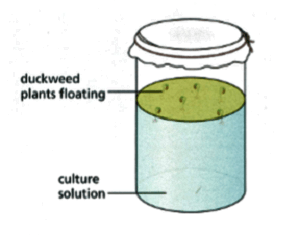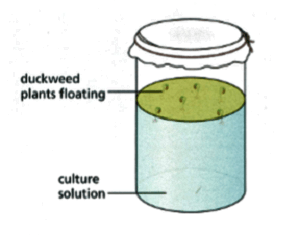What two types of substance do plant absorb through their roots?

Important Questions on Photosynthesis and Plant Growth
Thema wanted to investigate how different minerals affect the growth of plants. She used duckweed plants, which grow on water. Thema wanted to test how well plants grew in the absence of each of the following elements: nitrogen, potassium, magnesium and phosphorus. She set up six jars, half filling them with water and then adding nutrients to each to form a culture solution, as described below.

Jar 1: water only (a control, to see what happens to the plants when none of the minerals is present).
Jar 2: water, potassium, magnesium, phosphorus (no nitrogen).
Jar 2: water, nitrates, magnesium, phosphorus (no potassium).
Jar 4: water, nitrates, potassium, phosphorus (no magnesium)
Jar 5: water, nitrates, potassium, magnesium (no phosphorus)
Jar 6: water, nitrates, potassium, magnesium, phosphorus.
Thema put 10 duckweed plants in each jar and then left them for four weeks. Each week Thema collected evidence about the jars, including the area of the water surface covered by plants, root length and colour of the plants.
Explain why Thema put many plants in each jar, rather than just one plant.
Thema wanted to investigate how different minerals affect the growth of plants. She used duckweed plants, which grow on water. Thema wanted to test how well plants grew in the absence of each of the following elements: nitrogen, potassium, magnesium and phosphorus. She set up six jars, half filling them with water and then adding nutrients to each to form a culture solution, as described below.

Jar 1: water only (a control, to see what happens to the plants when none of the minerals are present).
Jar 2: water, potassium, magnesium, phosphorus (no nitrogen).
Jar 2: water, nitrates, magnesium, phosphorus (no potassium).
Jar 4: water, nitrates, potassium, phosphorus (no magnesium)
Jar 5: water, nitrates, potassium, magnesium (no phosphorus)
Jar 6: water, nitrates, potassium, magnesium, phosphorus.
Thema put 10 duckweed plants in each jar and then left them for four weeks. Each week Thema collected evidence about the jars, including the area of the water surface covered by plants, root length and colour of the plants.
What would you predict the plants in each jar to look like after four weeks?

In the given figure, which are the most important elements?
